Diospyros virginiana
I’d like to begin by prefacing this article with a warning: I am a huge fan of American persimmons.
I’ll take one of these over an apple or pear – or even an Asian persimmon – any day of the week.
If you’re looking for an unbiased account of American persimmons, head elsewhere, my friend.
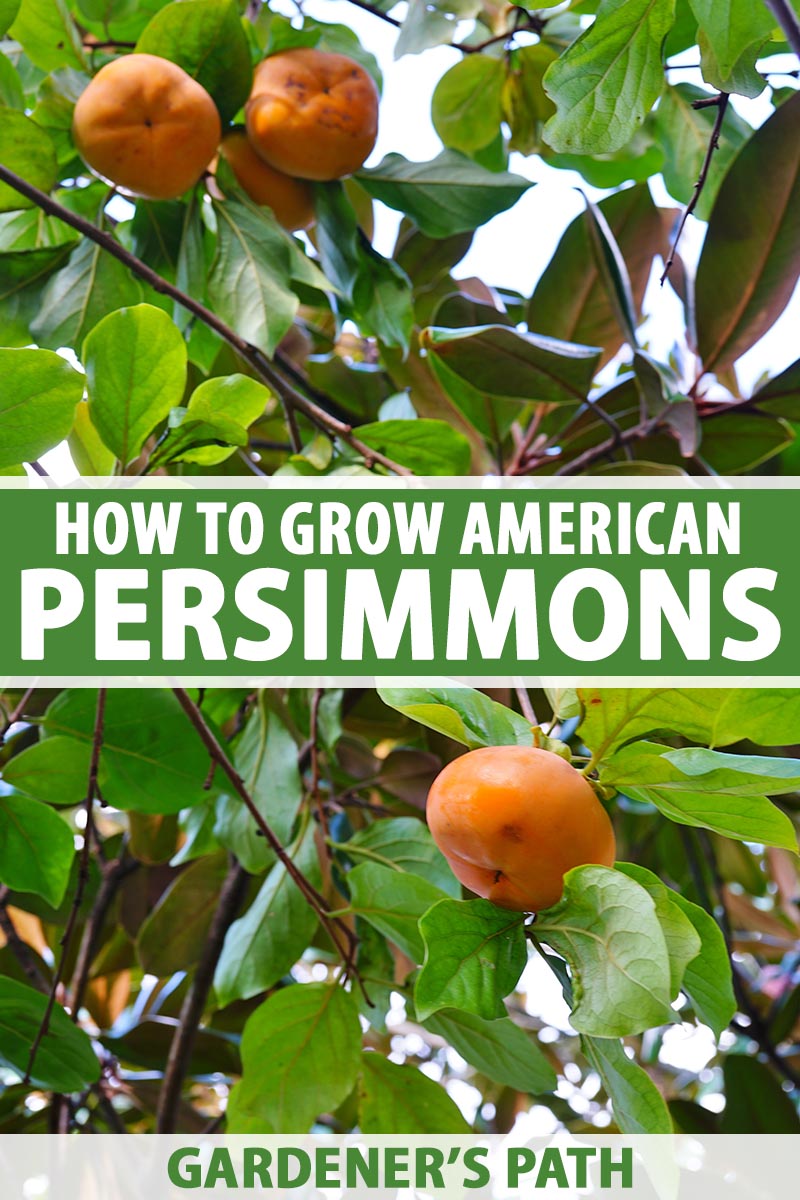
We link to vendors to help you find relevant products. If you buy from one of our links, we may earn a commission.
But if you’re a hardcore advocate like I am, a native plant lover, or simply someone who’s interested in adding a new variety of fruit to the garden, then you’ve come to the right place.
D. virginiana hits all the marks for me, and I’m confident that it will for you as well.
They are easy to care for, without all that intricate pruning and frequent spraying that certain other fruit trees (cough – peaches – cough) require. They can grow in just about any type of soil and they’ll forgive you if they don’t get enough water on occasion.
Despite all that appalling imagined neglect, they’ll reward you with stunningly flavorful fruit with a taste that is complex and sweet.
It’s hard to describe the flavor of the ripe fruit exactly, but it’s sort of like if a ripe peach was sprinkled with cinnamon and cloves, and wrapped in caramel. The texture is like the most heavenly pudding you can imagine.
Okay, yes – if you’ve ever taken a bite of an unripe astringent persimmon, you won’t ever forget the cottony, puckery experience of tasting the tannin-filled fruit.
I suspect that’s part of the reason that American or “common” persimmons don’t get as much love as their relative D. kaki, the Asian persimmon, of which non-astringent cultivars are available that are lower in tannins. These have to be extremely soft before they’re edible.
On top of that, the fruits don’t travel well. They aren’t commonly cultivated, and their native range is much smaller than that of their Asian cousins.
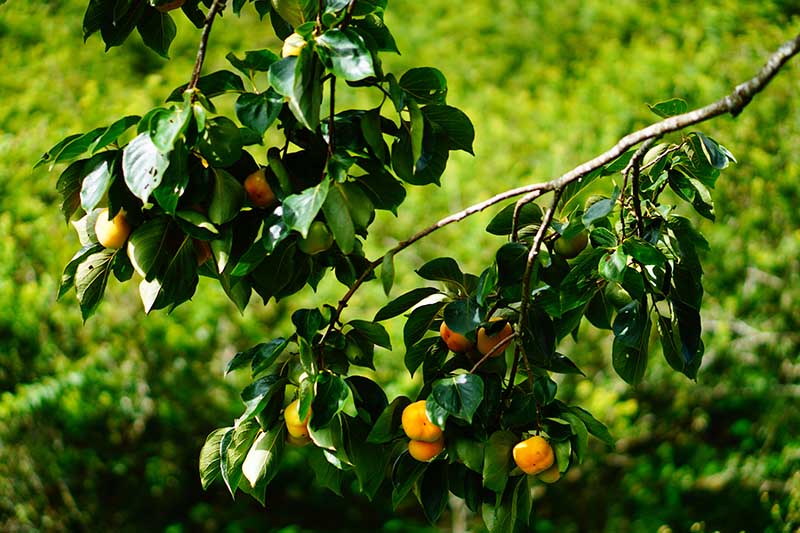
If you’ve ever bought one of the pretty orange orbs at the grocery store, bitten into it while it was still firm, and it didn’t make your mouth pucker, that was an Asian fruit.
Cultivars of this species – like ‘Fuyu’ and ‘Hachiya’ – are far, far more popular across the world, no doubt because the fruit travels better, and certain varieties still taste good even when they’re not quite ripe.
But American persimmons are intensely flavorful. The trees are more pest and disease resistant than their cousins, and have better tolerance of the cold as well. Personally, I think these fruits need a better public relations team.
Until that happens, I’ll do my best to fill that gap. Ready to become a convert?
By the time you finish reading this guide, you’ll be ready to sing the praises of D. virginiana. And if you live in the right location, I bet you’ll be more than ready to add a tree or two to your garden.
Here’s everything we’ll discuss:
What You’ll Learn
I tend to automatically distrust anyone who says “trust me” but… trust me! If you’re looking for a fruit tree that doesn’t demand lots of attention and care, this is it.
Once you get the hang of when it’s time to pick the fruit for optimal flavor, you’ll be dreaming of the incomparable taste of the petite fruits all year long until harvest season rolls around again.
What Is the American Persimmon?
Also known as Eastern persimmon, possumwood, American ebony, or butterwood, the American or common persimmon is native to the southern and eastern regions of the US stretching from Florida to Connecticut and Iowa to Texas. They also grow native in parts of California and Utah.

Additionally, you can find them today growing in orchards in Oregon, Washington, Arizona, and New Mexico. They grow best in USDA Hardiness Zones 5-9, with a few cultivars that are hardy down to the cold winter temperatures of Zone 4.
The name for the genus Diospyros may be loosely translated from Greek to mean “fruit of the gods.” I think the edible species in this genus are aptly named because their flavor is heavenly.
Part of the Ebony family (Ebenaceae), they are closely related to the Asian persimmon (D. kaki) as well as several other edible species including black sapote (D. digyna), velvet apple (D. discolor), and date plum (D. lotus).
The Texas persimmon (D. texana), which is native to Texas and Mexico, is another closely related member of the genus that produces small purple fruit.
American persimmon trees reach somewhere between 30 and 60 feet tall on average, but they can reach heights of 90 feet or more under optimal conditions.
Trees generally start producing full loads of fruit when they are about seven years old, and their most productive age is often between 25 and 50 years. They can live for up to 150 years.
While most cultivars available to home growers are self-pollinating, most wild trees are dioecious, meaning they produce flowers that are either all male or all female. Both are required for pollination, and fruit is produced only by the females.
The leaves are medium green, oval, and large, about six inches long and three inches wide. In the fall, the leaves may turn yellow or reddish-purple before they drop to the ground.

Large off-white flowers may bloom from early March through June, with the specific timing of the bloom phase depending on the region.
Because they typically flower later in the season than many other types of fruit trees, you generally won’t have to worry about late frosts impacting yields at harvest time.
The trees bloom in late April in my region, Zone 8b in Oregon, which is well after the last average frost date.
Fruits ripen from early September through December, depending on the cultivar.

Mature fruits are about one to two inches in diameter, though a few cultivars grow larger. The unripe fruit is high in tannins, which many an unlucky kid has discovered when they’ve pulled the fruit off the tree for a surreptitious snack.
One of the major differences between the fruit of Asian trees and of American trees is that the fruit of D. virginiana should generally be soft and overripe before you try to eat it.
Almost every single cultivar of American persimmon, as well as native wild fruit, is mouth-puckeringly astringent when the fruit is underripe.
However, some cultivars sweeten up younger than others, and a few cultivars are even ready for eating before they turn soft.
In recent years, a few breeders have created non-astringent cultivars, and that’s exciting news for American persimmon lovers! If you want to learn more about these, check out the section on recommended cultivars below.
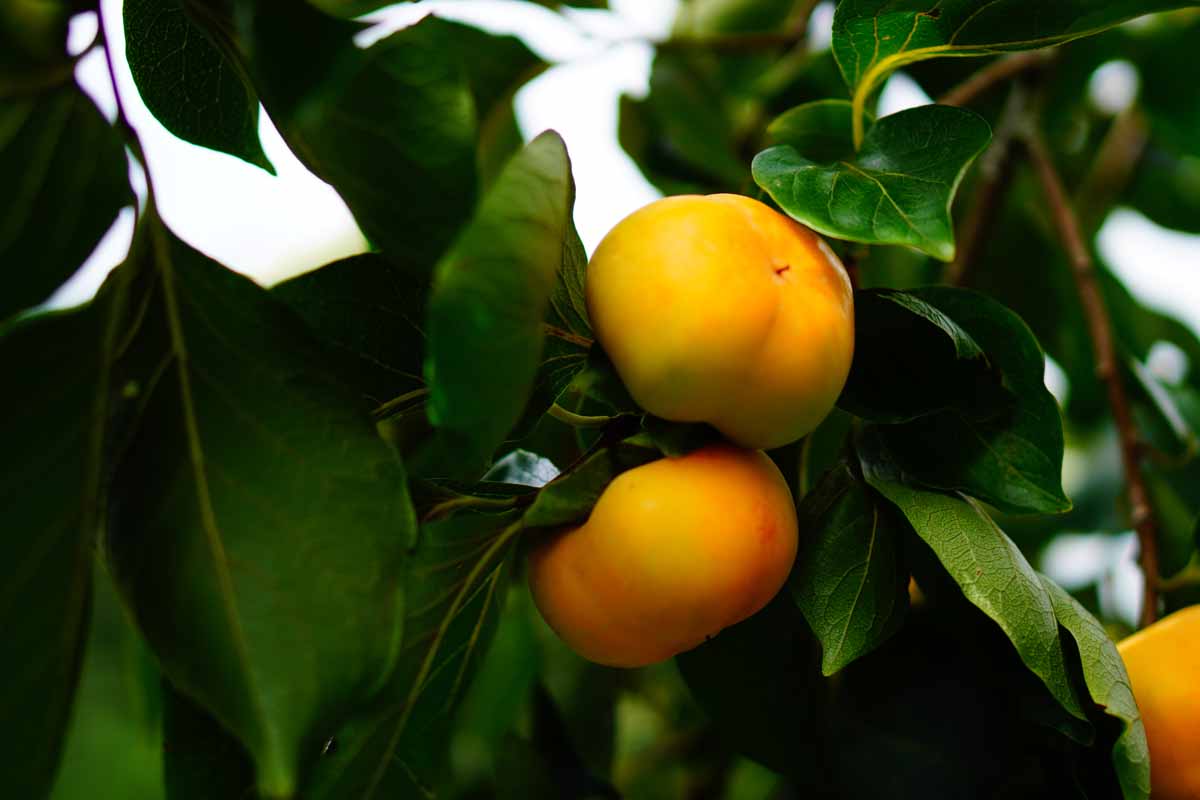
The pulp of the fruit is gelatinous and darker than the skin, and fruit may or may not have seeds, depending on whether or not it has been pollinated and the particular cultivar.
The pulp often contains imperfections, brown discoloration or little black spots, but these aren’t anything to worry about. It’s normal, but some people find it unattractive, especially in the processed pulp. You can, however, find a few cultivars that lack these little spots.
As with many fruit trees, plants can produce a heavy crop in one year, followed by a lighter crop the next year. This is known as alternate or biennial bearing.
This happens when a tree devotes all of its energy to producing fruit one year and doesn’t have as much energy to produce the same amount of flowers and fruits the next year.
Cultivation and History
Until recently, like pawpaws and other native fruits, American persimmons were gathered in the wild rather than being cultivated in gardens.
Native Americans valued the fruits, and people from the Cree and Delaware tribes called the fruit pasiminan (or pessemmin, pushemin, pichamin or putchamin, depending on the dialect or spelling), which means dried fruit in Algonquian.

Some native people from the Osage and Quapaw tribes made loaves of mashed, boiled, and sun-dried or grilled pulp, while other tribes dried them to preserve the fruits.
Later, European settlers learned to appreciate the native fruits as well. Spanish and French explorers described the fruit as something like a plum or medlar.
When Captain John Smith of Jamestown bit into a persimmon, he found the experience… less than impressive, according to C.H. Briand, who wrote for the Hunt Institute of Botanical Documentation.
“… if it be not ripe will drawe a mans mouth awrie, with much torment,” he wrote. When ripe, however, he said that the fruit was “… as delicious as an Apricock.”
The plants, including the bark and leaves, have been used medicinally to treat diarrhea, dysentery, fever, syphilis, and thrush, among other ailments.
The fruit has also been used to create alcoholic beverages, including beer, brandy, and wine. During the American Civil War, the seeds were used as a coffee substitute, and vinegar was made out of the pulp.
Because it has such a recent history of cultivation, we have a pretty good idea of how and when the wild plants started to be shaped by human gardeners.
Early breeders in the late 1800s included horticulture professor James Troop of Purdue University and member of the Iowa State Horticultural Society, and F. O. Harrington, from York Center, Iowa.
More recently, plant breeder James Claypool worked with over 2,000 different persimmon cultivars to select trees with improved pest and disease resistance that produced larger, better tasting fruit, and fruit that ripened earlier.
Joseph C. McDaniel, a professor of horticulture at University of Illinois, has also made a big impact on the domestication and breeding of these trees, and is responsible for the selection of ‘John Rick’ and ‘Florence.’
I would be remiss to neglect mentioning Jerry Lehman. A grower with an experimental orchard in Indiana who passed away in 2019, Lehman wanted to help farmers in Indiana by creating a common persimmon that could be grown by commercial farmers there, and he dedicated a good chunk of his life to making that happen.
He sought not only to improve the flavor and size of the persimmon fruit so that they would appeal to buyers, but he also bred the few non-astringent cultivars that exist today.

Persimmons have even featured as fixtures of gardening folklore used to predict the weather.
For instance, cracking open the seeds and finding cotyledons shaped like a spoon are said to indicate a snowy winter ahead, while fork-shaped cotyledons indicate a mild season to come, and knife-shaped seed innards are said to predict bitter cold.
When it comes to American varieties, there are two types: tetraploids with 60 chromosomes, and hexaploids with 90 chromosomes. Similar to avocados as another fruit that has several races in cultivation, with 90-chromosome types and 60-chromosome types.
Almost all cultivars you can purchase or find in breeding programs are 90-chromosome types.
These don’t need pollination from another variety to fruit, and they produce larger persimmons that usually ripen earlier and are a bit sweeter than that of the 60-chromosome types. Tetraploid (60-chromosome) varieties require pollination for fruit production.
When a 60-chromosome tree pollinates a 90-chromosome tree, the resulting fruits are usually seedless, or nearly so.
Propagation
As is the case with most types of fruit trees, you have a variety of options for propagating persimmons, from starting seeds to digging up and transplanting suckers.
Whichever method you choose, it’s generally a smart idea to test your soil before planting, to make sure it doesn’t have any serious deficiencies of nitrogen, potassium, or phosphorus (NPK).
Work in some well-rotted compost if your soil is particularly compacted or nutrient-poor. You can also add some sand to loosen up clay earth.
Remember that you must plant a male and a female tree of different varieties together for pollination, unless you select a self-pollinating cultivar. American persimmons won’t cross-pollinate with Asian ones.
If you have a type that requires another tree for pollination, it helps to plant flowers that attract pollinators like bees and butterflies around your tree.
You won’t know whether you have a male or female until they produce flowers.
From Seed
As with most deciduous fruit trees, common persimmons won’t grow true to type from seed. Seeds also have a low germination rate, and it won’t be possible to tell the males from the females for quite some time. However, if you have quite a bit of time on your hands and you’re looking for an affordable project to try at home, this may be the way to go.
Keep in mind that when you start from seed, your plants may not produce a good-sized harvest for up to a decade – and in some cases, not at all.
However, persimmons that are sown directly wherever you intend to grow them are better able to adapt to the site, even if that site happens to have poor drainage or if it is overly rocky.
You can also start seeds indoors in containers if you prefer. Plan on getting your seeds into their containers about ten weeks before the last frost in your area in the spring.
While they aren’t common, you can purchase seeds from specialty retailers.
You must cold stratify seeds before planting them. That means wrapping them in a moist paper towel and putting that in a zip-top bag. Place the seeds in the refrigerator for three months, frequently checking to make sure the towel is moist.
After three months have passed, plant the seeds an inch deep in a seed-starting medium in a four-inch container, or put them in the soil where you intend to grow them.
Make sure to put the seed in the soil with the “eye” facing up. That’s the rounded end that has a slight opening.
You should consider using biodegradable peat pots that can be planted directly in the ground to reduce the amount of trauma to the roots that’s caused during transplanting.
Keep the soil moist but not wet as they grow. Think of a well-wrung-out sponge and you have a good idea of the level of moisture you’re aiming for.
As mentioned, the seeds have a low germination rate and they can take up to two months to germinate. Consider planting far more than you need, to ensure that you have a few healthy seedlings and at least one female and one male plant.
Place potted seedlings in an area where they receive bright, indirect light for eight hours a day.
Once they’ve grown a few leaves and are at least six inches tall, you can plant them in the garden in the spring, after all risk of frost has passed. Plant container-grown seedlings as you would transplants (covered below) after a period of hardening off.
Hardening off is a process of gradually introducing the plant to outdoor conditions. Typically, this means taking the seedling outside for an hour and putting it in indirect sunlight.
The next day, add an hour, and another hour the next day, until the plant can stay outside in indirect sunlight for eight hours. Then, it’s ready to go in the ground.

You can purchase packages of 30, 50, or 100 seeds via Amazon.
From Cuttings
I love taking cuttings from fruit trees because it’s such an easy way to duplicate a plant you love.
In the spring, after the plant has emerged from dormancy and leafed out, select a branch that’s about as thick as a pencil and take a cutting that’s about 10 inches long. Remove the leaves from the bottom half of the cutting.
Be sure to take cuttings from both a male and female tree if you don’t have access to a self-pollinating cultivar.
Slice the cut end at an angle of about 45 to 60 degrees and dip it in powdered rooting hormone or a cloning gel.
I prefer to use Olivia’s Cloning Gel, and you can pick some up at Arbico Organics.
Prepare the soil outdoors by working in some well-rotted compost, or fill a six-inch pot with potting soil. Stick a pencil or chopstick into the soil to create a hole, and insert the cutting about halfway. Gently press the soil around the cutting to firm it in place.
Water well, and keep the soil moist but not soggy as the cutting begins to take root, which will happen in about four weeks. At that point, you should see some new leaves forming.
Give the twig a gentle tug to see if it resists. If it does, that means roots have formed. Treat rooted cuttings like other transplants at this point, and put the plants in the ground about a month before the first frost arrives in your area if you’ve grown them in containers.
From Suckers
Asian persimmon trees don’t send up suckers, but American ones do. Suckers are the little upshoots that come out of the soil a few feet away from the plant. They’re attached to the roots underground, and you can use them to propagate new trees.
They have the same genetic makeup as the parent tree, which means you’ll need to collect suckers from a male and female tree if you don’t have a self-pollinating cultivar.
The best time of year to harvest them is in the spring when plants are sending up new growth, but before it gets too hot.
Locate a sucker with at least three leaves and gently dig around it. You don’t want to get too close to the roots to avoid damaging them, so leave a four-inch margin around the sucker as you dig. Gently remove soil until you encounter the main root, then snip away the sucker from the main root with pruners.
Trim away the horizontal root, leaving the vertical, fibrous roots in place.
If the sucker has more than three leaves, trim away the excess leaves to encourage new roots to grow rather than foliage.
Plant the sucker in prepared soil outdoors or in a container with potting soil. Keep the soil moist for the first few months.
If you planted in a container, transplant in the fall, following the instructions for transplanting.
From Bare Roots
Bare root plants should go in the ground in the early spring. You don’t want to plant them too late, after the bare root emerges from dormancy and starts developing new growth as they will become stressed and may not survive transplanting.
Before you put them in the ground, clip away any dead roots or branches.
It can be hard to tell if the roots are alive or dead, since they’re often black or dark brown, so give them a little bend. If they feel soft and bounce back, they’re alive. If they snap, snip the root off.
You should also prune back the length of the stems by about half to encourage bushier growth and to ensure that the roots are not overly burdened by too much top growth while they’re first getting established.
Plant as you would a transplant.
From Seedlings and Transplanting
I believe American persimmon transplants are getting easier to find, and there are more varieties than ever thanks to the breeders who are working to create improved cultivars. If you want to get your hands on some homegrown fruit quickly, purchasing a sapling is the way to go.
The best time to plant nursery grown seedlings and saplings is either in the spring, after the risk of frost has passed, or in the fall, a few weeks before the projected first frost in your area.
If you have a cultivar that isn’t self-pollinating, purchasing transplants is an easy way to ensure you’re getting both a male and a female tree. Make sure to put them no further than 50 feet apart to facilitate pollination, and no less than 20 feet apart from each other and from any nearby structures to allow for adequate airflow and room to grow.
Remember that because these trees have long, deep taproots, you won’t be able to transplant them later if they get too big or start to encroach on a fence, building, or other plants.
Once you’ve acquired your plant, prepare the soil and dig a hole slightly wider and at least twice as deep as the container it’s growing in. Gently remove the transplant from its container. I find it’s easiest to carefully press the sides of the plastic container or roll it gently along the ground to loosen the soil ball.
Fill in the hole with soil so that the plant will sit at the same level it was while growing in the container. The reason we dig deeper than we need is so that those deep roots will be encouraged to grow down into the soil, and so the earth is loose and easy to expand down into.
Place the plant in the hole and gently fill in around the root ball with additional soil. Water well.
Persimmons develop deep taproots, which makes them difficult to transplant as they mature. Make sure to get your transplants in the ground as quickly as possible after purchase, and choose a location where they can grow permanently, for the duration of their lives.
I say this as someone who has been guilty of buying a plant or two and then leaving them in their containers for months before I get around to planting. You can get away with that kind of bad behavior with a hosta, as I’ve discovered, but you might be sorry when your persimmon fails to thrive.
It’s a good idea to use a stake kit at planting to prevent your sapling from leaning or being buffeted by high winds.
Nature Hills Nursery carries the Dewitt Tree Support Stake Kit, which includes everything you need.
How to Grow American Persimmons
Unless you live in an area that gets frigid in the winters, this is a tree that is fairly adaptable to a wide variety of conditions.
D. virginiana can survive temperatures down to -25°F, but if you live somewhere that regularly experiences temperatures lower than this, you can forget about growing this tree. Sorry!
This species can handle poor soil that is low in nutrients, rocky, or sandy, poorly-draining sites, and pretty much everything in between.
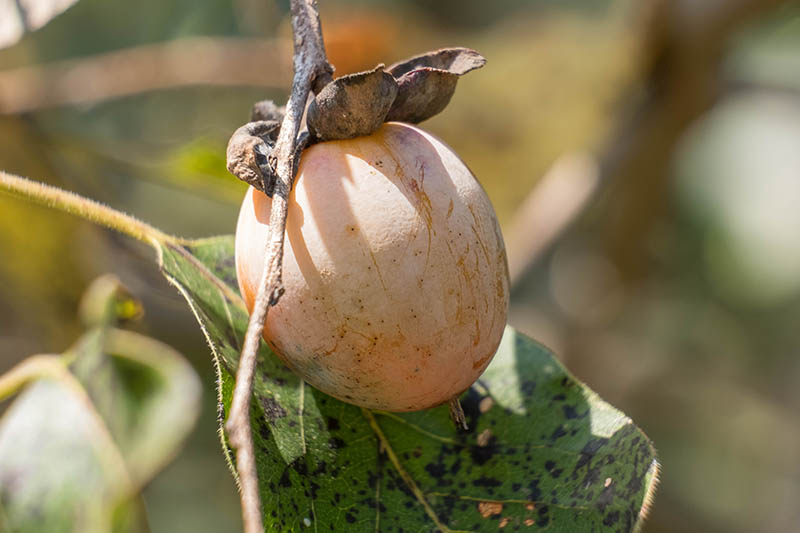
Of course, you want to try to give your trees the ideal conditions that they prefer to grow and thrive if you want good harvests with high yields, and to avoid diseases.
That means planting in well-drained, loamy soil. Aim for a pH between 6.0 and 6.5.
Plants need full sun to produce and reach their full potential, but they can grow in partial sun or partial shade as well. You’ll likely get fewer fruits if they’re growing in the shade than you would in full sun.
Keep the plants well-watered when they are young, but as they mature, they can handle some drought. Plan on providing around an inch of water per week during the growing season, assuming that you don’t get any rain.
The top two inches of the soil should be allowed to dry out in between waterings.
Apply a balanced fertilizer every year in the spring, starting after the plant has reached an age where it has begun to produce fruit.

Dr. Earth’s Fruit Tree Fertilizer
I like Dr. Earth’s Fruit Tree Fertilizer, which you can find at Amazon. Apply as directed on the package.
Place an inch-thick layer of organic mulch, such as rotted wood chips to aid moisture retention and provide nutrients to the soil.
Apply it out to the drip line, but avoid placing any right against the trunk of the tree. A six-inch margin is ideal. Re-apply the mulch yearly in the spring.
Pruning, Training, and Maintenance
While it isn’t necessary, pruning can improve your harvest and make your trees look more attractive.
For young plants under the age of five, prune away weak, thin, diseased, or crossing branches in the early spring, before new growth has emerged.
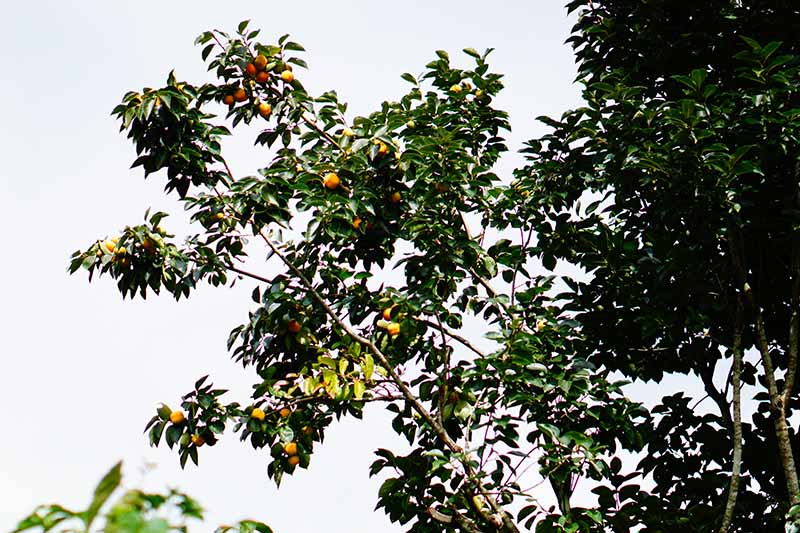
Retain branches with wide crotch angles, since narrow crotch angles create weak branches that may crack or snap when they’re laden with fruit.
You want to leave about five main branches toward the outside to form the main structure of your tree.
As new shoots emerge in the spring, for the first five years, trim them about a third of the way back to encourage branching.
After that point, you can stop pruning your young trees this way and focus on maintenance.
When it comes to maintenance pruning, you don’t need to fuss much too much if you don’t want to.
Too much pruning leads to fruit drop, so be mindful of that and don’t go overboard. That said, a little bit of pruning encourages new growth and because flowers and fruit emerge from new wood, this can result in higher yields.

If desired, prune the tree in the winter to create a visually pleasing shape, after the leaves have fallen and before any new growth has started.
I like to keep my plants a bit rounded, so I remove any branches that stick out taller than the rest. If you don’t mind it if your plants have a bit of a more natural look, don’t worry about pruning for shape.
Remove any diseased or dead branches throughout the year. I also like to thin the tree slightly by removing any branches that rub or cross whenever I notice them.
Most common cultivars don’t grow nearly as tall as the wild trees do, topping out around 30 feet. If your tree grows taller, you may want to prune it back to make harvesting easier.
Fruits that grow too high up are difficult to harvest, and if they fall to the ground from that high when they’re ripe, they will burst into a mushy mess.
Remember how we talked about alternate bearing above? Not all persimmons experience this, but if yours does, you can help level things out by removing some of the fruit when it is young and still forming.
Flowers that produce next year’s crop are already starting to form while the tree is fruiting. If it’s producing a heavy crop, this can take away much of the energy required for flower production and result in a smaller harvest the following season.
Use a pair of clippers to evenly snip away one-third of the developing fruits on each branch.
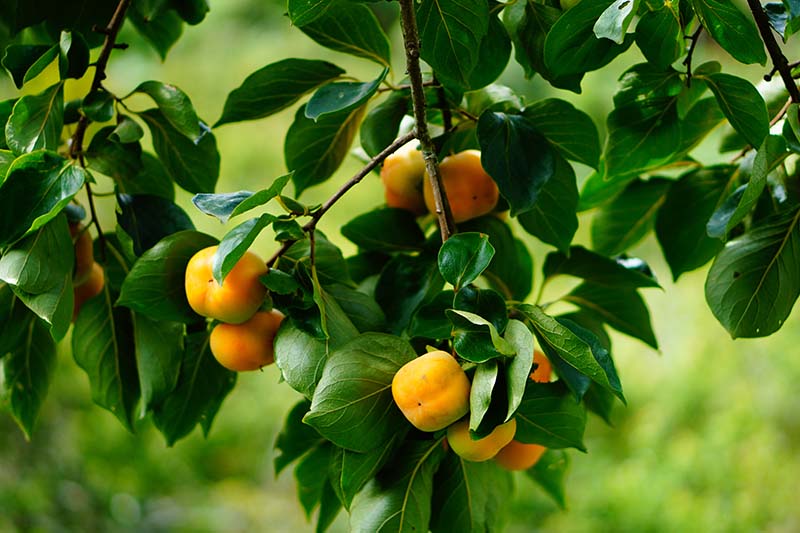
American persimmons send up lots of suckers, and you’ll need to pull them up or cut them down whenever they emerge from the ground.
It’s a never-ending job, but if you let the suckers grow in place into full-sized trees, they’ll compete with your existing plant for nutrients and space.
If you want to propagate a few, follow the directions above. Otherwise, these can be tossed on the compost pile.
In the fall, be sure to clean up any fruit or fallen leaves.
This is a good idea in general for all fruit trees because it helps you avoid some of the pests and diseases that stick around over the winter in fallen leaves and fruit. Fallen fruit may also attract some unwanted wildlife into your garden.
Growing Tips
- Provide well-draining, loamy soil for healthy plants, and the best yields.
- Established plants can handle drought, but they should ideally be given regular water, about an inch a week.
- Pruning may help your plants produce a larger harvest, but it isn’t necessary for production.
Cultivars to Select
I have some bad news for you. Most large nurseries don’t carry common persimmons, or if they do, they sell them under a generic name with no information about the cultivar. But there are some wonderful cultivars out there that are worth seeking out.
Check with specialty nurseries or local enthusiasts to source plants. Nature Hills Nursery carries both bare root and saplings.
Deer Magnet
If you want to attract deer, you couldn’t ask for a better cultivar than ‘Deer Magnet.’
The fruit forms late in the year, from October through December, and stays on the tree well into the winter, providing food for deer and other hungry wildlife.
That doesn’t mean you can’t enjoy it, as well. It’s delicious, with two-inch fruits that have pungent, flavorful, sweet flesh. This astringent type needs to be overripe to be palatable.
These are even hardy down to Zone 4 and they are self-pollinating, so you don’t have to grow a male tree nearby to produce a harvest.
Dollywood
‘Dollywood’ produces delicious fruits, but what stands out about this tree is its growth habit. It doesn’t grow exceptionally tall, but spreads out with gracefully weeping branches. It makes a gorgeous ornamental option.
Fruit ripens in mid-September to late-October, though the harvest may continue as late as November. This type was one of Jerry Lehman’s most recommended varieties because the fruits don’t need to be overly ripe to enjoy them.
He also touted it as a prolific producer.
It’s self-pollinating, so it doesn’t need a buddy, but you’ll have a larger harvest if there is a male planted nearby.
Early Golden
This cultivar dates back to the 1800s and is the parent plant of many of the newer cultivars that breeders have created in recent decades.
It has golden orange fruit that grows to be about one and a half inches in diameter, with a sweet, mild flavor. The plant stays relatively small, topping out around 10 feet, so it’s ideal for container growing.
This is another type that can survive the winter as far north as Zone 4. Ready for harvest starting in September, it’s important to let the fruits soften before eating.
While it will produce some fruit without a male tree nearby, you’ll get a much better harvest if you plant with a male pollinator.
Early Jewel
This is one of the earliest fruiting types of American persimmons and it has extremely pretty bright red fruit, so its name couldn’t be a better fit.
It starts bearing earlier than most varieties and produces a consistent, heavy crop. The fruits are seedless and ready to pluck in September. When ripe, they are sweet and flavorful.
This is another self-pollinating cultivar.
Killen
Remember how I mentioned those black flecks in the pulp earlier? This variety doesn’t have any of that, and the flesh is known for being free of imperfections. The medium-sized fruits are exceptionally sweet and about an inch in diameter.
‘Killen’ reaches about 25 feet high when it’s mature, and the fruits are ready to pick around mid-October. Let them get soft before eating. No need for a second tree with this cultivar to get a harvest. It’s self-pollinating.
Lehman’s Delight
This is a newer self-pollinating cultivar, bred by Jerry Lehman. It has incredibly large fruit that grows up to three inches in diameter with smooth, sweet flesh.
The tree stays compact but it produces a lot of fruit with an excellent flavor. It’s late to ripen, with fruits starting in October. Fruits should be soft but they don’t need to be overly ripe before you can dig in.
Morris Burton
You know that unicorn of American persimmons that I touched on, the rare non-astringent variety? This is the granddaddy of them all.
Though the other existing non-astringent types haven’t been named or made widely available, they are all bred from ‘Morris Burton.’
It isn’t a prolific producer and can be slow to produce, but breeders are working on using it to create new varieties that are improved in these areas.
You can eat the fruit when it is firm, or let it ripen fully. It gets sweeter as it gets softer. This one is also self-fruitful.
Managing Pests and Disease
American persimmons are extremely resistant to pests and diseases. You won’t need to spray your trees to protect them against problems because they’re so readily able to withstand issues.
That said, there are a handful of things to watch out for. However, if you keep trees healthy by watering them appropriately, pruning if necessary, and planting them in a location where they receive a good amount of sun, they should be able to withstand most problems.
Also, be sure to clean up any plant debris in the fall.
Herbivores
While you might get a break from most pests and diseases while growing persimmons, you’re going to have to go to battle with animals that are looking for a snack.
Birds
All kinds of birds will dine on persimmons, from chunky turkeys to petite warblers. My advice for you is to either net your tree when the fruits are about a month away from harvest time, or just accept your fate.
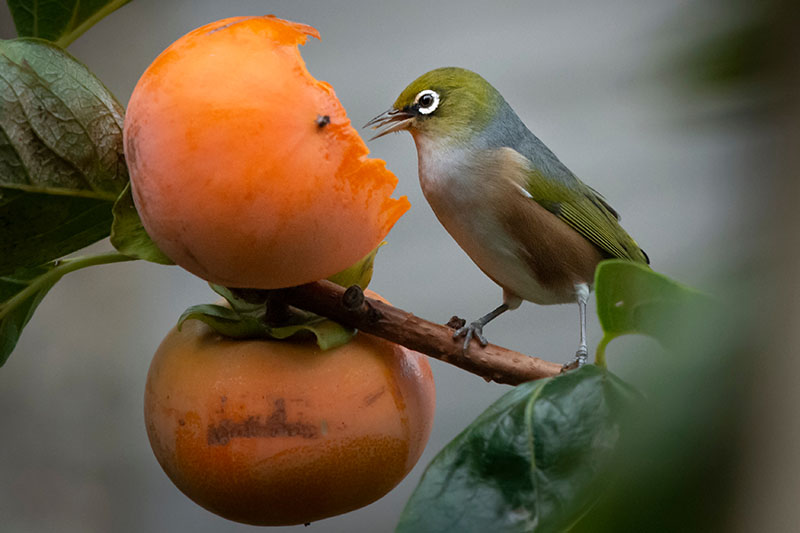
You’ll still get lots of fruits and the local bird population will thank you for the bounty.
As a bonus, birds can even help you to eliminate pests, not only from your persimmon trees, but from the rest of your garden as well. They’ll come for the fruit, and take care of the bugs as well.
In other words, you give the birds some food and they’ll help to keep your garden healthier. Win-win, right?
Deer
Deer love persimmons so much that when hunters want to attract them, they will often use a product made from the tasty fruits. Deer will nibble on the fallen fruits in your garden and in the wild, and they’ll grab low-hanging, ripe ones off the trees.
They’ll also eat the twigs and leaves, which is especially damaging to young trees or saplings.
Fencing is the best way to keep deer out of an orchard, in my opinion. We also have a full guide to keeping hungry ungulates out of your garden.
Rats
Rats and other types of rodents (as well as squirrels, but I’ll touch on them in a bit more detail below) are particularly fond of fallen fruit. You can be sure when fruits begin to pile up on the ground, the rats and mice are on their way.
Repellents work well to discourage rats from visiting your tree.
Arbico Organics carries Bonide™ Rat Magic. You can sprinkle the granules around the base of the tree to make it a less appealing option to rodents.
That said, your best bet is to rake up or remove any fallen fruit right away so that they don’t have a regular food source drawing them into the area.
Squirrels
In the grand scheme of things, squirrels aren’t that big of a deal, but they annoy me because they go for the fruits before they’ve had a chance to ripen. Sometimes they steal them, other times they just take a nibble from a bunch and leave them hanging on the tree.
Squirrel baffles or collars stop them from climbing up the trunks, but they can still leap from nearby trees or buildings into your trees. And if you’ve ever seen a determined squirrel, you’re well aware that there’s pretty much no stopping them.
Given that a squirrel’s large area to mass ratio means these animals can fall from any height and hit the ground at exactly the same speed, likely surviving, you have a real challenge on your hands.
If I was hungry and I knew jumping from the top of a house to a nearby tree and missing it probably wouldn’t kill me, I’d be leaping around like a maniac (which probably means I wouldn’t survive long in the wild).
You can purchase deterrents, but I don’t find they do much good when the squirrels are seeking persimmons. What works better is to put feeders in nearby trees to lure them away. With an additional food source that’s readily available, they shouldn’t eat enough fruits to really impact your harvest.
Insects
American persimmons are unbothered by insect pests for the most part, but they aren’t completely immune.
Here are the most common pests to watch for.
Borer
Persimmon trunk clearwing borers (Sannina uroceriformis) bore into the trunks of trees, as you might have guessed from the name.
The adults are black moths with a red band across their bodies. They look a little like wasps.
They lay eggs at the base of trees, and the larvae that hatch out bore into the plants, eventually tunneling up the trunks and pupating in cocoons.
The most serious damage occurs below ground, but you may notice frass (it looks like sawdust) or a black, gummy substance oozing out of infested trees. When the roots are damaged, trees may become weak and the leaves might wilt.
The bugs can even girdle a young tree and kill it.
If you suspect you have this particular pest, you’ll need to dig down into the root area and look for hollowed out roots and holes made by the borers at the base of the trunk.
You can cut out infected roots, and use a knife to dig out the bugs from inside the holes. Other than that, there is no effective control option available.
The best defense is a good offense, and healthy trees are less susceptible to succumbing to an infestation.
Hickory Horned Devil
I always think this pest sounds more like a high school mascot (go Hickory Horned Devils!) than an insect hell-bent on defoliating young persimmon trees, but (Citheronia regalis) is most definitely the latter.
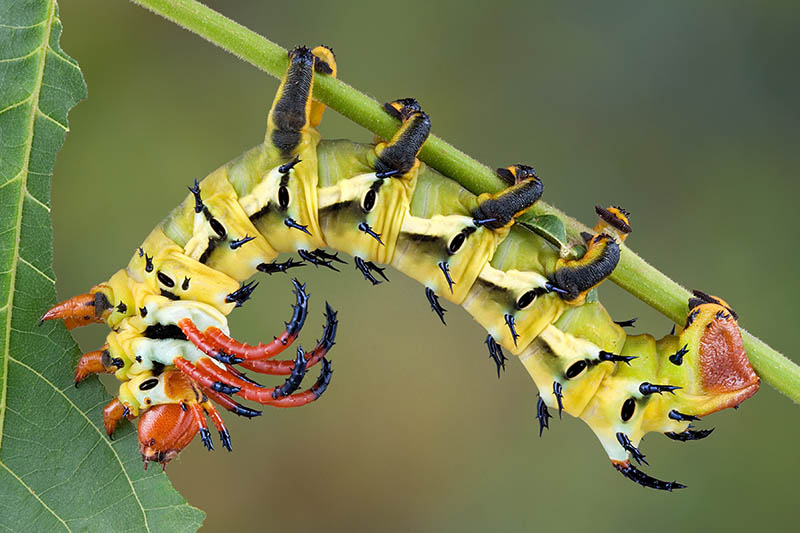
The adults are known as regal or royal walnut moths, and they are quite beautiful.
They are reddish-brown or orange with gray-green spots and yellow banding. They can have a wingspan of nearly six inches.
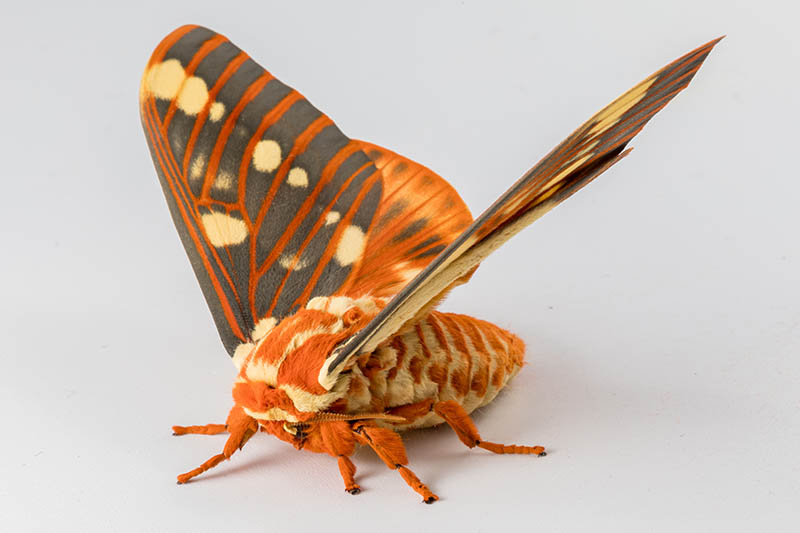
The caterpillars are also quite attractive looking, in my opinion, growing to about five inches long. They’re blue-green with orange and black-tipped scoli, protruding growths covered in black bristles, which look like a crown of horns.
They may have black markings on their heads and lower body segments, along with shorter black scoli along their bodies.
If you see either adult moths or the caterpillars, don’t kill them. They are an important native insect in the Eastern half of the US as pollinators and food sources for other animals.
So how do you stop them from chomping on the leaves of your trees? If you spot them on mature trees, just wave hello and leave them alone. A large tree won’t lose enough leaves to the nibbling caterpillars to be impacted.
If they are on a young tree under ten years old, gently remove them and place them on a mature persimmon tree instead, or on a mature hickory, sumac, or sweetgum tree because these plants also serve as hosts.
These caterpillars also have several natural predators, including parasitic wasps and flies.
Persimmon Psyllid
These tiny pests (Baeoalitriozus diospyri or Trioza diospyri) are black or tan insects about the size of an aphid (about 0.15 an inch). They can fly or jump and they secrete honeydew as they suck on plant juices.
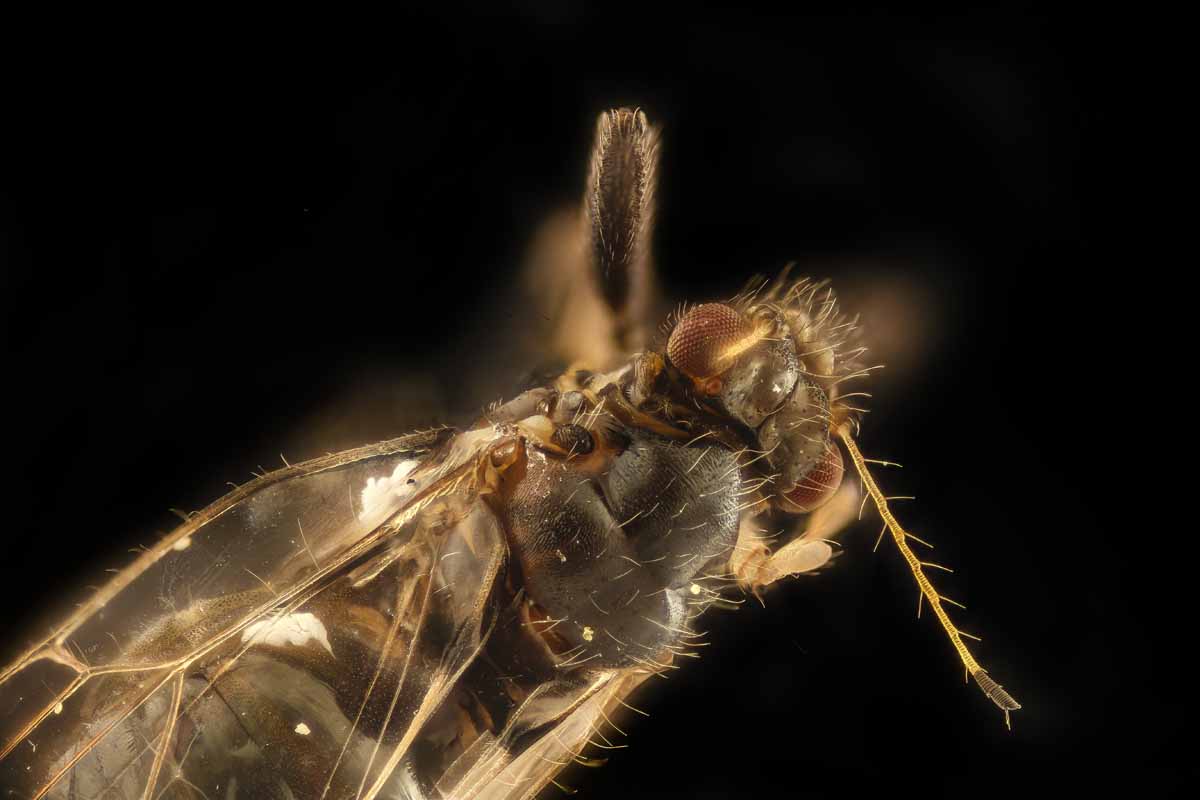
They are most common in the spring as the weather starts to warm up. Once it gets hot, the populations tend to shrink.
While they can harm Asian trees, they tend to not cause much damage to American varieties. Native wasps and other natural predators tend to keep numbers under control.
If they do cause some damage, you might see curled or distorted leaves.
Monterey horticultural oil, available at Arbico Organics, controls populations without harming beneficial insects.
Spray on trees in the springs as the bugs start to emerge.
Twig Girdler
Twig girdlers (Oncideres cingulata) are little beetles that not only attack persimmons, but hickories, elms, and pecan trees as well. Even worse, they spread persimmon wilt.
An adult female lays eggs in the early fall, girdling stems by gnawing a circle around the branches as she does so. She lays her eggs in that circular cut, and eventually, the branch may fall to the ground so her offspring can dig down into the soil.
The adults are gray and about three quarters of an inch long. They have two dark bands across their wings and long antennae.
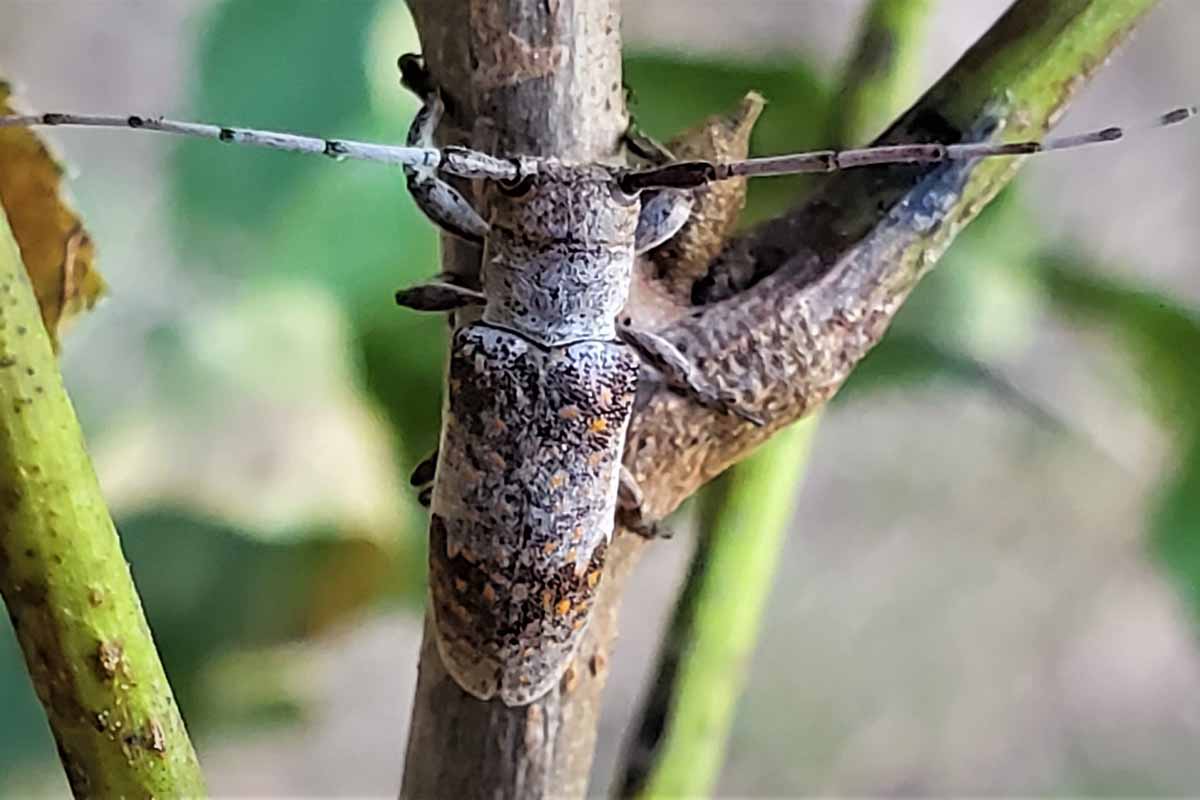
The falling branches aren’t a big deal, and you could safely ignore this pest if it didn’t spread disease. Unfortunately that is not the case, but luckily for you, control is easy.
Pick up any fallen branches right away and burn them to kill the larvae. If you can’t burn plant debris in your area, seal them in a bag and toss them in the trash.
That doesn’t stop the disease from spreading, however, since these bugs carry persimmon wilt and have already nibbled on your tree. That means it’s too late to stop them from potentially transmitting the disease to your plant.
Read more about this disease below to learn how to deal if your tree comes down with wilt.
Webworm
Webworms (Seiarctica echo) can seriously damage young trees, though older trees are more resistant to harm.
It’s easy to tell if you have this pest in your yard because you’ll notice big white tent-like nests in persimmon, sweetgum, pecan, and other types of trees.
The pests hang out in the soil underneath leaf litter during the winter while they pupate, and emerge in the spring as white moths. They lay eggs on the leaves, which hatch into caterpillars that spin silken webs.
The caterpillars create tents for protection and they feed on foliage inside these webs. That can spell disaster for a young tree.
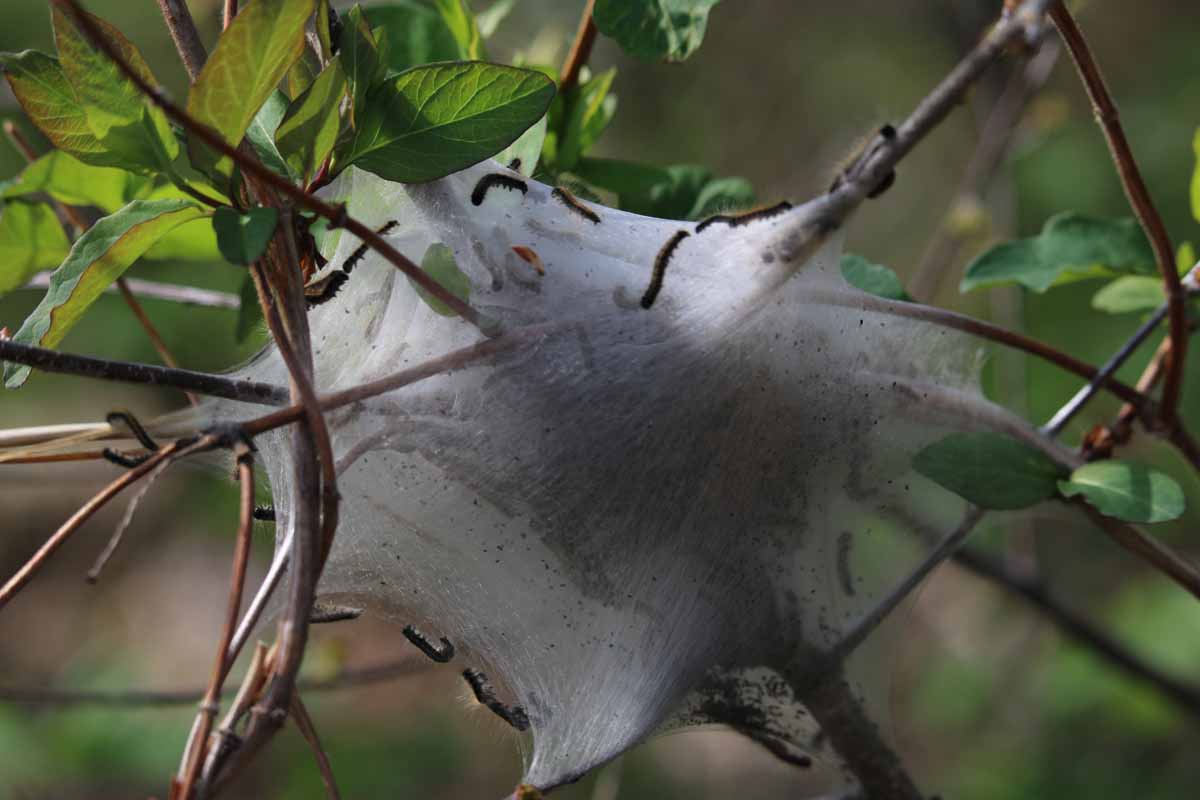
This is the part that gives me the chills to write, but it’s the best way to control these pests:
Go outside with a broom or rake when you see the webs, and sweep the worms out and away from the tree.
I’m warning you right now, wear a hood. And maybe a hazmat suit. Okay, that may be a bit extreme, but after you’ve found a few of these fuzzy wigglers in your hair or crawling down the back of your neck, you won’t want to mess around.
Once you’ve knocked the webs out, rake up the ground surrounding the tree and burn them or bag them up, seal the bag, and toss it in the trash. In the fall, clean up all of the fallen leaf litter to deny them a place to overwinter.
Disease
American persimmons are bothered by just a few diseases, and as with pests, it’s pretty rare that you’ll encounter them.
To help avoid diseases, don’t plant your persimmon with peach or mango trees, which suffer from similar issues.
Anthracnose
Also called leaf spot, anthracnose is caused by types of fungi in the Colletotrichum genus. An adult tree won’t die from this disease, but it can impact your harvest.
You’ll see dropping leaves, and foliage that’s covered in black spots. The spots can be sunken into the surface of foliage, and you may see lesions on the bark as well as the fruit.
Bonide™ Copper Fungicide dust, available at Arbico Organics, is a good treatment option to cure the disease, and you can apply it up to about a week before harvest.
Combine it with water in a hand sprayer and cover the tree as soon as you notice symptoms of this disease. You may need to spray more than once, but use caution. Copper can build up in the soil and kill beneficial microbes.
Persimmon Wilt
Remember how I said persimmons are pretty resistant to disease? This one might be its Achilles’ heel. Cephalosporium diospyri can kill a tree within a few months.
The first sign is wilting foliage, which starts at the top of the tree. Then you’ll see bark beginning to separate from the tree, with red blisters underneath. If you cut the tree down, you’ll see black streaks throughout the rings.
Eventually, the bark ruptures, and the spores escape into the air to attack other trees.
This fungal disease can infect trees that have been damaged by twig girdlers, and the bugs carry the fungi. Controlling these insects is your best bet for keeping this disease away.
If your trees incur any damage from pruning, weed whacking, or mowing, these should be covered with wax to prevent the fungus from taking hold. This is especially true if there are any other trees that have been attacked by the fungus already.
If a tree becomes extremely infected, you’ll need to cut it down and burn it to prevent the fungus from spreading. You can also cut the entire tree down and dispose of it, but don’t use any parts in your compost pile or you risk spreading the fungus.
Harvesting Persimmon Fruit
Trees take about four to nine years to start fruiting if you planted a young seedling. Grafted trees and saplings are faster because they are older when you purchase them, and these are typically ready to harvest from in just three to five years.
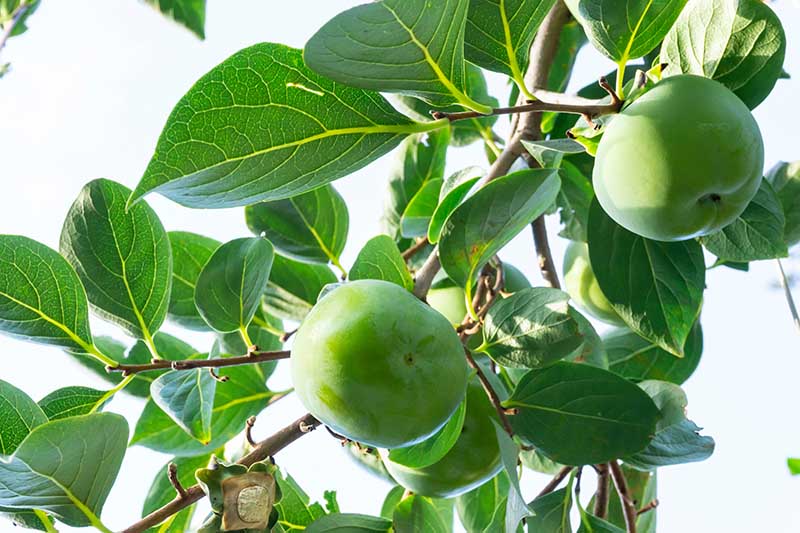
A mature tree can give you anywhere between 35 to 75 pounds of fruit per season, depending on the growing conditions and the cultivar.
There’s a common misconception that you have to let American persimmons go through a frost before you can harvest the fruit. In reality, you simply need to wait for the fruit to become completely ripe, which takes time.
When you go out to pick your fruits, don’t use a bag! I know they’re convenient, but the fruits will get all mushy and smashed, and you’ll end up with a bag full of persimmon mess. Use a bucket or basket with firm sides instead, and don’t pack them too deep.
Snip the fruits off the tree using a pair of pruners, and leave the cap in place when harvesting.
The green, leafy cap at the stem end is technically known as the calyx. Leaving it in place helps the fruit stay fresh longer.
You can also lay out tarps or a three-inch layer of straw and let the ripe fruit fall on their own. Just make sure to go out and grab them before the rodents, deer, or wild turkeys do.
If you plucked your treasures before they ripened fully, put them in a bowl with fruit that puts off a high amount of ethylene gas, such as apples or bananas. This will hasten the ripening process.
You can learn more about how to harvest persimmons in this guide.
Preserving
Ripe fruit can be kept in the refrigerator for about a week, or you can freeze the fruits for up to nine months.
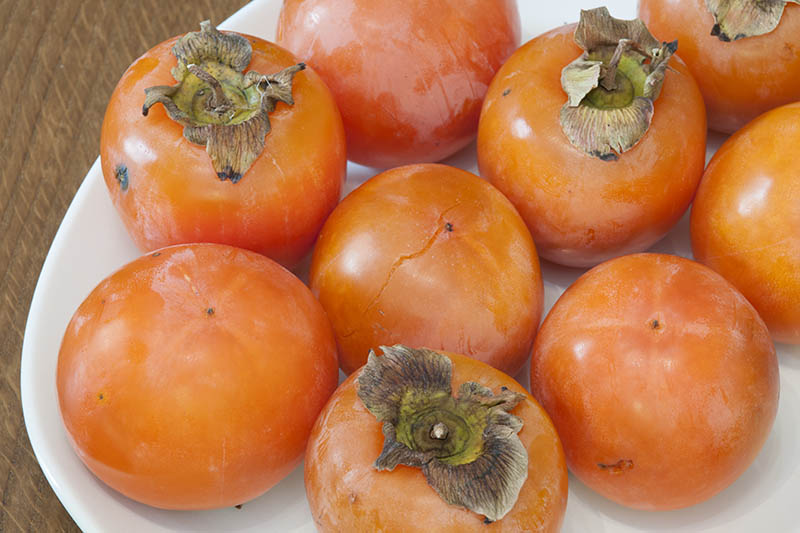
Freezing can also help to remove the astringency if you had to pluck your fruits from the tree before they were fully ripe.
To do this, wash the fruits and slice them into quarters after harvesting. Wrap them in foil or place them in plastic baggies and seal them up. After they have frozen solid for at least 24 hours, remove them from the freezer and allow them to thaw out completely.
It actually appears to be the thawing process that removes the tannins, so don’t skip this step and take a bite out of a frozen persimmon!
You can also freeze whole, ripe fruits for eating later. Wash and dry them and place them in a sealable plastic bag. If they were ripe before freezing, you can slice them in half after they have thawed slightly and eat the frozen flesh like a sorbet. It’s delicious.
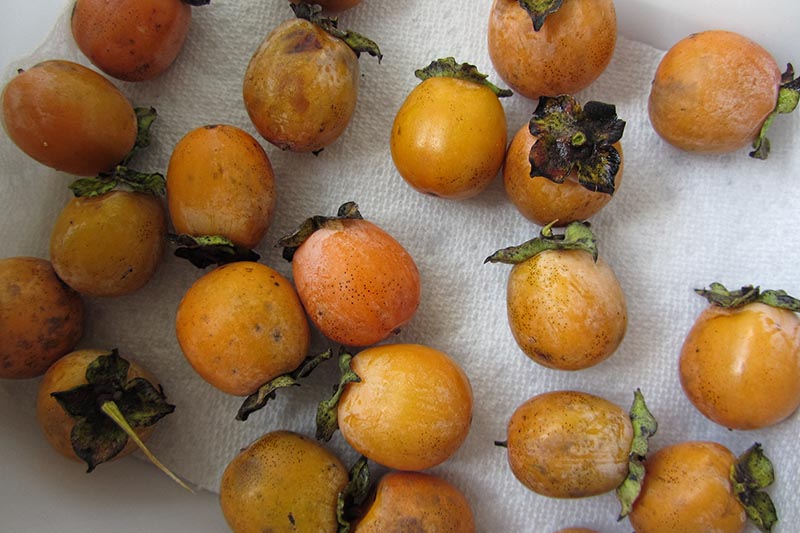
Dried persimmons are a delight. They’re sort of like a date in flavor, but with subtle notes of clove, caramel, and cinnamon.
To dry whole fruits, you need to start with ones that are slightly underripe. If you try to dry the extremely ripe ones, you’ll end up with a finished product that is chewy on the outside with a weird, unappealing brown powder inside where the flesh used to be.
If you have fruits with seeds, you may want to slice them in half and remove them first so you don’t have to contend with seeds when you’re eating the finished product.
You can go the old-fashioned way or the speedy way to dry the fruits. The old-fashioned way involves washing, drying, and putting them on drying racks over a wood stove, or hanging them in an area that is dry and warm. Turn or rotate the fruits daily, and in a few weeks, they should be good to go.
The fast way involves putting the cleaned fruits in a food dehydrator, or you could dry them in the oven on the lowest setting, which is usually around 170°F.
Place the fruits on a baking sheet and put them in the middle position of the oven. Bake until they are dry and leathery, typically for around 10 hours, checking them occasionally.
If you’re interested in adding a food dehydrator to your collection of kitchen appliances to help you to preserve your homegrown harvest, you can read all about these on our sister site, Foodal.
Finally, processing the pulp to make a puree for storage allows you to enjoy the fruits for a long while, particularly in homemade desserts. Slice the fruits in half, scoop out the flesh, and pick out any seeds. Put it in a bowl and blend it with a hand blender, or pour it into a blender or food processor and puree it.
Lay a piece of cheesecloth or place a sieve over a bowl and pour the pulp into it to remove any impurities, like small seeds or bits of skin. Remember that the pulp might have black flecks in it, but this doesn’t impact the flavor or quality.
Freeze the pulp in jars for up to a year, or store it in the fridge for three months. The pulp is out-of-this-world for use in desserts or as a topping for yogurt, which is what we’ll talk about next.
Recipes and Cooking Ideas
Oranges are often in the spotlight when it comes to high vitamin C content, but persimmons (both Asian and American) actually contain more of this nutrient than citrus fruits.

One fruit contains about 66 milligrams of vitamin C, while a mandarin orange contains just under 27 milligrams.
Remember Jerry Lehman, who worked so hard in his lifetime to create commercially viable persimmons? He shared his family recipe for persimmon pudding over at Farm Flavor.
I can tell you from experience that it’s well worth whipping up. It’s rich, dense, and mildly sweet with the fruity spice of the persimmon front and center.
You can also turn the pulp into a tasty fruit leather. To make it, lay plastic wrap on a cookie sheet and spread a thin layer of pulp over the plastic. Put it in the oven at the lowest setting possible.
Let it bake in the oven for a few hours until it reaches the consistency you like. My sister and I used to fight over whether it’s best slightly gooey, like taffy, or crispy and dry, like potato chips.
The best part of the process is testing as you try to figure out the answer to this.
Try using the pulp in breads, cocktails, cookies, cakes, and as a topping for ice cream.
Quick Reference Growing Guide
| Plant Type: | Perennial fruit tree | Maintenance: | Low |
| Native to: | Eastern and southern United States | Tolerance: | Clay soil, drought, frost |
| Hardiness (USDA Zone): | 4-9 | Soil Type: | Loamy |
| Season: | Spring, fall | Soil pH: | 6.0-6.5 |
| Exposure: | Full sun to part shade | Soil Drainage: | Well-draining |
| Time to Maturity: | Up to 10 years from seed | Companion Planting: | Flowering plants that attract pollinators like bee balm, coneflowers, marigolds, milkweed, nepeta, Russian sage, snapdragons |
| Spacing: | 20 feet, depending on cultivar | Avoid Planting With: | Carrots, mangoes, peaches |
| Planting Depth: | 1 inch (seeds), same as root ball (transplants) | Order: | Ericales |
| Height: | 90 feet or more for wild trees, about 25 feet for cultivated trees | Family: | Ebenaceae |
| Spread: | 25 feet or more | Genus: | Diospyros |
| Water Needs: | Moderate | Species: | virginiana |
| Common Pests: | Birds, deer, rats, squirrels, borers, hickory horned devils, persimmon psyllids, twig girdlers, webworms | Common Diseases: | Anthracnose, persimmon wilt |
American Persimmons Are Finally Getting Their Due
Many fruit trees require careful pruning and regular spraying if you want a robust harvest, but American persimmons aren’t nearly so much work.
You don’t even have to harvest the fruits. Just lay out a tarp and let the bounty come to you.

I realize that a fruit that requires that you grow it yourself if you want a taste probably won’t ever be as popular as one that you can buy practically anywhere, but I think that just makes them all the more special.
Are you growing American persimmons? Let us know in the comments section below, and share your tips with the community!
And for more information about growing fruit trees in your garden, check out these guides next:
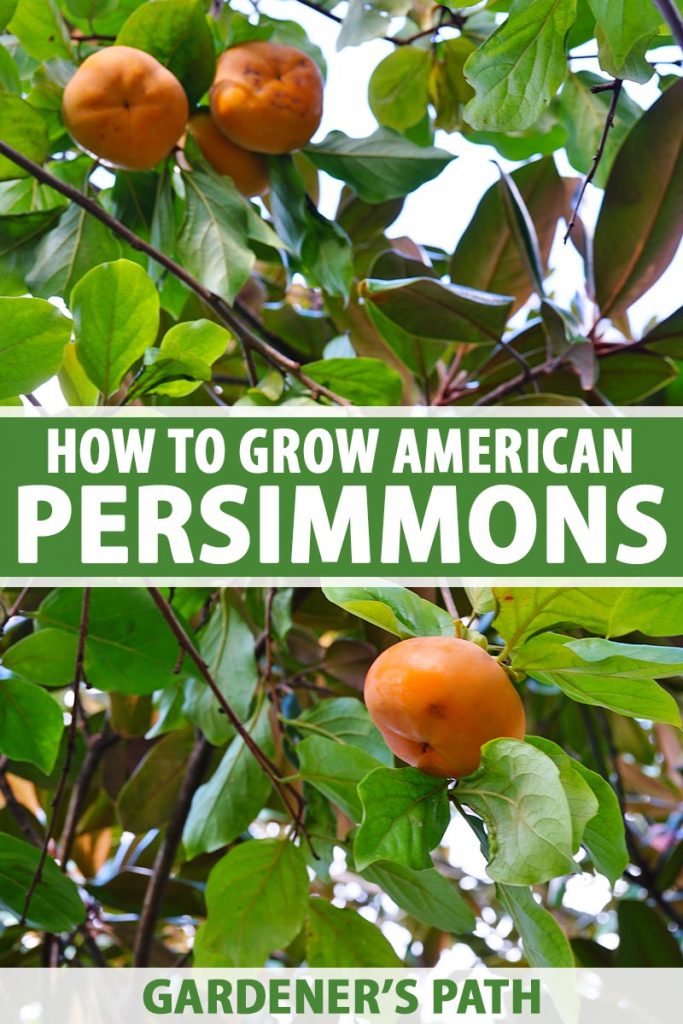
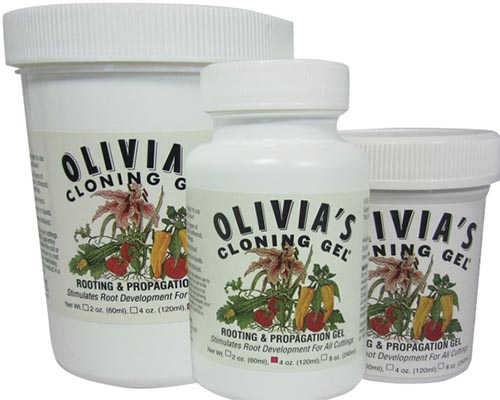
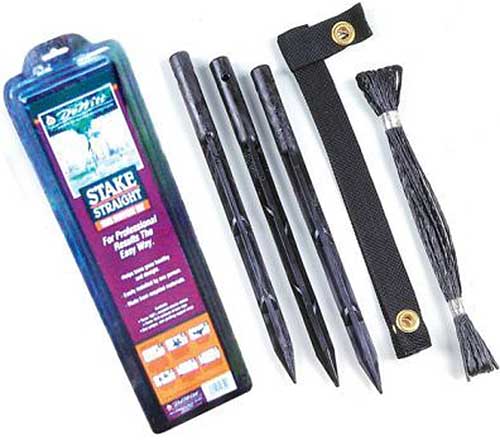

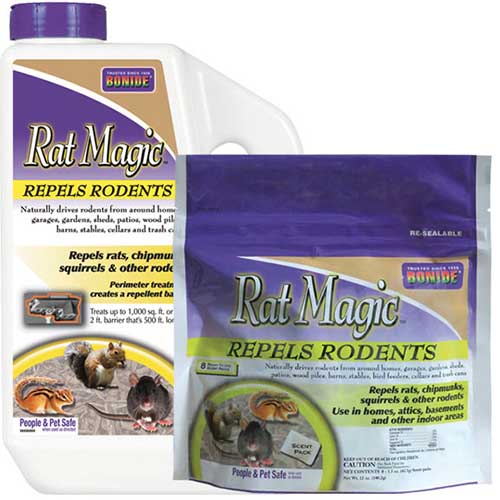
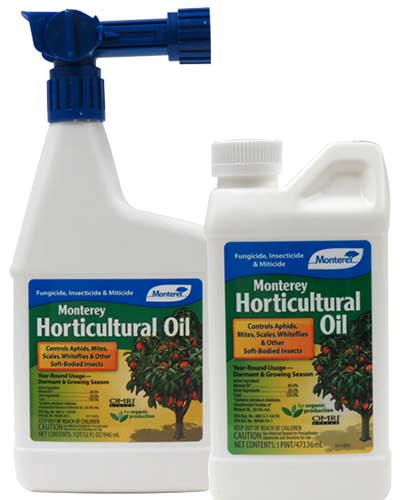

Welcome to Oregon! I just spent the day collecting American persimmons from trees that my grandfather started from seeds his brother had brought from Oklahoma (IIRC.) This is the first year I’ve actually made it out there after the fruit was ripe, and before it was rotting on the ground, though I think they’ve only be fruiting for a handful of years now (I first noticed the fruit about 4 years ago, and mistook the green fruit for some kind of nut.) Ended up coming home with about 15 cups of fruit today, with really 2-3 times that amount still… Read more »
Thank you! I still wake up every day and am blown away by how beautiful Oregon is! How fortunate you have access to an American persimmon tree. Do you know what cultivar(s) you have there? Suckers are by far the easiest method I’ve found to propogate the trees, but I have friends who swear by cuttings. Let me know how seeding goes – that’s on my list to try once my trees start producing. Enjoy your fruit – how do you use it up?
My camp is in NE W, TN. Persimmons are short lived here, prob from Persimmon Wilt.
It’s really sad there’s been no?? research on supplements to make them resistant.
I used to raid my grandmother’s gnarled old persimmon tree as a child in Kansas City, then never saw the fruit again for forty years when I discovered the Asian variety in a Bangkok market. I bought an old cow pasture on the northern Washington coast in 2017, and persimmons were among the first trees I planted. Sadly, it is not going well. My Meader died a long slow death; my Prairie Dawn is sluggish and unhappy; and my Nikita’s Gift Asian/American hybrid is beautiful in the autumn but remains tiny. I suspect a watering problem since Sequim, in the… Read more »
I have the same struggle here outside of Portland (McMinnville area). The dry summers and wet winters are a challenge. I think mounding for drainage and some improved summer irrigation might solve both our challenges. Let me know how it goes.
Hello! Just purchased property in Indiana (from Minnesota/Wisconsin) and, while I’ve never heard persimmons, we have a BIG persimmon tree in our side yard! (At least 100 ft) Before figuring out what they were, my chickens and dogs sure did enjoy them 🙂 Once I understood what they are, however, I’m gathering them up every day and muddling to collect the pulp. I’ve already tried the persimmon pudding and did persimmon muffins this morning for church 🙂 Delicious❤️ My biggest question is- what type of common persimmon do I have? – I think the answer is Deer Magnet though… It… Read more »
Any chance you could send in some pictures? I know it might be a bit late to snap a picture of the fruit and leaves, but that can help in our attempts to identify your tree. How large are the fruits?
Happy our guide could help!
I’ve been picking persimmons here in Southport, NC these last few weeks. While I’m familiar with the astringent ones, I’ve never had this particular variety before that does not pucker in my mouth. It looks exactly like the last picture of a persimmon tree in your post. What variety is that?
You definitely have to wait until they are practically jam and falling off the tree for most American persimmons. They can be really astringent.
I’m sorry, I can’t say for sure what type is in the picture, since the photographer didn’t specify and the fruits can vary a lot in appearance on a single tree or branch.
Cultivated trees tend to have sweeter fruits than wild ones. I can tell you that the sweetest cultivars out there based on grower opinion are ‘Morris Burton,’ ‘Meader,’ ‘Prok,’ and ‘Szukis.’
If I take a cutting from a male persimmon tree, will I be guaranteed it will grow a male persimmon tree? Thanks!
Hi Scott, yep. Cutting is a method of asexual propagation, and this method results in a second tree that is genetically identical to the parent. So if you propagate a male tree, you will have a male offspring. Now, having said that, persimmons have been known to change gender, so keep that in mind as your new tree matures.
Thanks!!!
I have 3 female trees but just one male. I would like to grow another male tree in case something happy to the one I have.
My most productive tree is so loaded this year that some of the limbs are breaking.
I had to wrap the trunks because in past years young bears would climb them.
Great article on persimmon, very informative.
Would John Rick and Szukis be good varieties to grow just outside Chattanooga TN? And where can I get them? Everywhere I find is out of stock, if they even list them.
‘John Rick’ and ‘Szukis’ (as well as its parent ‘Early Golden’) would all be great options for all parts of Tennessee. You might wait a few weeks to check for more online resources as most places tend to stock up soon for spring. You could also check local nurseries. Not only might they have the plants you’re looking for, but they can advise you on what grows best in your area.
Hello. Great article very full of all info anyone could want. My question is how can I get a hold of Persimmon Jerry Lehman’s. Self fertile please. 2 for sure in case one dies. Who do I contact since I’m guessing they may be so Special only few places may have them. Shipping of course will be needed. Thx for everything you wrote today about my favorite of fall fruits in the markets.
Gerald
Hello,
It can be a little challenging to find them, but try searching your local nursery or online nurseries for ‘Lehman’s Delight’ or ‘100-46’ American persimmon. This is one of the most common of Lehman’s persimmons. It’s partially self-fruitful, so you’ll be better off with a partner, but a single tree will still produce fruits. It’s a marvelous tree and worth having. Good luck with your search!
I live in NYC and have a persimmon in my backyard. We moved into the home last October and the tree was one reason why. It is leaning heavily to one side and much over a neighbor’s yard. I will have to prune/cut off the branch that is hanging over and about to make a mess when all that fruit falls. The fruit is starting to turn yellow. I am going to take some pics and post them when I get back home.
Hi,
Really enjoyed reading your article on persimmons!
I live in the Catskill Mountains of New York State, zone 5. Was considering the American Persimmon Trees, but wondering how many I would need to buy/plant to get fruit due to the pollination? A local nursery will be getting some potted ones in that are about 5-6 ft tall. Also, have another option to get some Meader ones, but they are very small plant, and will have to be shipped. They are not bare root.
The Meader sounds very interesting too. What would you recommend for starting out with Persimmons?
Hi George, most named cultivars that you can buy at nurseries are self-pollinating. ‘Meader,’ for instance, doesn’t need a friend to pollinate. If you don’t select one that is self-pollinating, you generally want one male for every six to eight female trees.
‘Meader’ has been bred to be fairly trouble-free, drought-tolerant, reliable, and easy to grow. ‘Early Golden’ is also an excellent option to start with.
You can’t go wrong with trying something from a local nursery. They usually know what grows best locally and will carry things that are suited to your area. Best of luck! They’re wonderful trees!